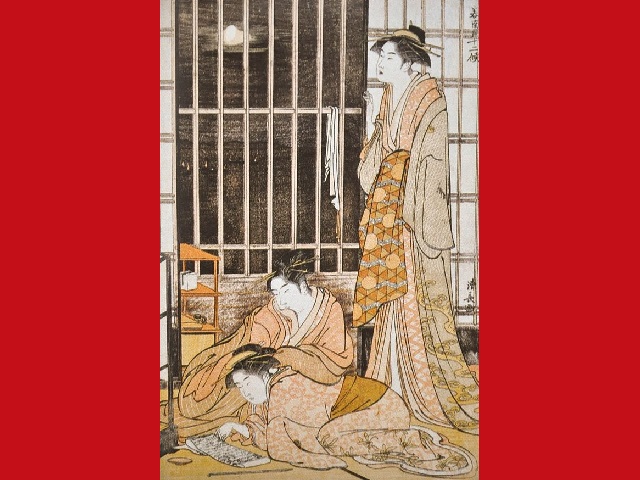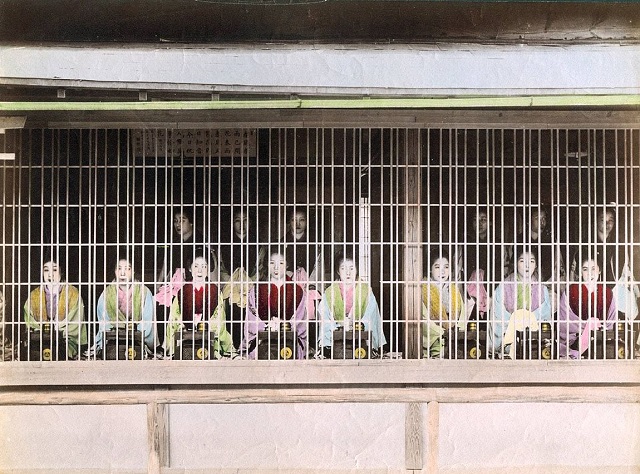
Yoshiwara was once where men with money to burn came to entertain themselves, while this woman was eating rotten pickles, or sometimes nothing at all.
In Japanese entertainment media, the Edo period is an often romanticized part in the country’s history, and it’s not hard to see why. Lasting from 1615 to 1868, the Edo period is sandwiched between centuries of bloody civil war and the rapid industrialization and expansionist policies which put Japan on the path to the international conflicts that ultimately resulted in its defeat in World War II.
So in the popular imagination, the Edo period is frequently thought of as a peaceful interlude in which Japan was both free of internal conflict and isolated from the complications of the larger world. Sometimes, even the Edo era’s pleasure quarters are viewed through rose-colored lenses, with novels, manga, and movies centered on beautiful courtesans whose charms and insightful wisdom turn the story of her life into a colorful and lavish tapestry of the sunset of Japan’s shogunate days.
But reality wasn’t always so luxurious for the women who serviced men’s desires in Edo’s brothels, as shown in this excerpt from historical researcher Yuriko Yokoyama’s Umemoto Records, which records the meals eaten by a prostitute working in the Yoshiwara pleasure quarter of Edo (present-day Tokyo) in 1850.
▼ The list was displayed as part of an exhibition on gender inequality in Japanese history, attended by Japanese Twitter user @kusikurage.
「性差の日本史」展で見た衝撃の資料の一つがこの、とある江戸末期ごろの遊女の食事の記録。こんなん普通に飢えて死ぬやろというレベル。でも生きて、しかも夜遅くまで客を取らされていたというのだから。平均寿命(年齢じゃなく寿命)が19〜20歳だったというのも頷ける。 pic.twitter.com/GYeYuE9VxH
— 櫛 海月 (@kusikurage) November 29, 2020
The list was compiled by the woman herself, who recorded her morning and evening meals in her diary between March 7 and April 6.
3-7 Morning: Rotten pickles and ochazuke [rice with green tea poured over it]
Evening: Rice gruel) with salmon head
3-8 Morning: Warm rice with rotten pickles
Evening: Did not eat
3-9 Morning: Rice gruel with greens
Evening: Pickles and ochazuke
3-10 Morning: No entry
Evening: No entry
3-11 Morning: Pickles and ochazuke
Evening: Stewed clams
3-12 Morning: Pickles and ochazuke
Evening: Bad pickles and ochazuke
3-13 Morning: Rice gruel
Evening: Roasted mitsuba celery roots
3-14 Morning: Rice gruel
Evening: No entry
3-15 Morning: Did not eat
Evening: Did not eat
3-16 Morning: Did not eat
Evening: Did not eat
3-17 Morning: Rice gruel with dried daikon leaves
Evening: Did not eat, secretly partook of roasted beans and sake
3-18 Morning: Pickles and ochazuke
Evening: Pickles and ochazuke
3-19 Morning: Did not eat (shiodachi fasting [a practice of not eating in order to receive a desired blessing])
Evening: Pickles and ochazuke
3-20 Morning: Rotten pickles and ochazuke
Evening: Clam soup and rice
3-21 Morning: Was asleep
Evening: Clam soup and warm rice
3-22 Morning: Was asleep
Evening: Pickles and ochazuke
3-23 Morning: Rice porridge and pickles
Evening: Rice porridge and pickles
3-24 Morning: Potato soup and warm rice
Evening: Rice gruel with potato, was not given pickles
3-25 Morning: No entry
Evening: Pickles and ochazuke
3-26 Morning: Rice gruel with potato
Evening: Pickles and ochazuke
3-27 Morning: Warm rice and pickles
Evening: Ochazuke
3-28 Morning: Pickles and ochazuke
Evening: Was allowed to eat two sardines. Drank sake
3-29 Morning: Was asleep
Evening: Rice porridge
3-30 Morning: Warm rice and pickles
Evening: Ochazuke
4-1 Morning: Daikon radish strip soup and warm rice
Evening: Rice gruel
4-2 Morning: Pickles and ochazuke
Evening: Pickles and ochazuke
4-3 Morning: Pickles and ochazuke
Evening: Pickles and ochazuke
4-4 Morning: Pickles and ochazuke
Evening: Pickles and ochazuke
4-5 Morning: Cracked barley soup
Evening: Pickles and ochazuke
4-6 Morning: Cracked barley soup, clams
Evening: No entry
▼ A Yoshiwara brothel, with prostitutes on display in a caged window
It’s worth bearing in mind that even in 1850, across the board Japanese people’s diets consisted, proportionately, of far more rice and pickles than they do today. Beef, pork, and chicken were also not commonly eaten during the Edo period and many of the historical periods preceding it. So by modern standards, even an Edo person of moderate means would likely appear to be eating decidedly meager meals. The specific mentions of “warm” rice, as though it’s a special treat, may not have been entirely unique to the prostitute’s position either, as living in an age without electric rice cookers or microwaves meant making a fresh batch of rice wasn’t as quick and easy as it was today, and heating up leftovers on their own wasn’t always possible (thus all the times porridge, gruel, and ochazuke are listed instead of plain rice).
That said, the woman’s diary lists several times when she didn’t eat at all, most shockingly when over three days, March 15 to 17, she had just one meal, and it’s not hard to reason that some of those “slept through morning meal” entries are due to exhaustion from the previous night’s work. There’s also more than one mention of rotten pickles, and even when there’s something to eat that’s neither rice nor rotten, it’s sometimes the least desirable portion, such as daikon leaves (as opposed to the root vegetable itself) or salmon head (as opposed to a meatier, more nourishing cut).
@kusikurage claims that the average life expectancy of an Edo-period prostitute was a mere 20 years. Again, life expectancies in general were much shorter in Japan in the 1850s than they are today, when they’re some of the highest in the world, but 20 is still incredibly young. That doesn’t necessarily mean that the women of Edo’s brothels were all starving to death, but sporadic, low-nutrition meals couldn’t have been good for the diary writer’s overall constitution, especially in a profession that carries so many other health risks as well, and it’s a reminder that as intriguing as the past may be, the present is overall a much nicer time to be living in.
Source: Yuriko Yokoyama via Twitter/@kusikurage via Hachima Kiko
Top image: Wikipedia/Ismoon (edited by SoraNews24)
Insert image: Wikipedia/Gryffindor
● Want to hear about SoraNews24’s latest articles as soon as they’re published? Follow us on Facebook and Twitter!


 Using Starbucks Japan’s hot water to make ochazuke, one of Japan’s best comfort foods
Using Starbucks Japan’s hot water to make ochazuke, one of Japan’s best comfort foods Make potato chips twice as delicious by soaking them in green tea before eating them【SoraKitchen】
Make potato chips twice as delicious by soaking them in green tea before eating them【SoraKitchen】 Sushi for breakfast? Our under-1,000-yen breakfast with Hama Sushi’s new morning menu
Sushi for breakfast? Our under-1,000-yen breakfast with Hama Sushi’s new morning menu No one asked but we did it anyways: MOS rice patty burgers X ochazuke【Taste test】
No one asked but we did it anyways: MOS rice patty burgers X ochazuke【Taste test】 Salamander soup?!? We try “giant salamander rice with green tea” in Kyoto
Salamander soup?!? We try “giant salamander rice with green tea” in Kyoto Japan’s new difficult-to-drink-from beer glass protects your liver, but it’s a brutal experience
Japan’s new difficult-to-drink-from beer glass protects your liver, but it’s a brutal experience How to order snacks on a Shinkansen bullet train in Japan
How to order snacks on a Shinkansen bullet train in Japan New samurai glasses are Japan’s latest weird must-have souvenir
New samurai glasses are Japan’s latest weird must-have souvenir “Deflowering” services for virgin women are now a thing in Japan, apparently
“Deflowering” services for virgin women are now a thing in Japan, apparently Doraemon found buried at sea as scene from 1993 anime becomes real life【Photos】
Doraemon found buried at sea as scene from 1993 anime becomes real life【Photos】 Burger King Japan suddenly adds Dr. Pepper and Dr. Pepper floats to its menu nationwide
Burger King Japan suddenly adds Dr. Pepper and Dr. Pepper floats to its menu nationwide Hello, cosmetics! Clinique teams up with Hello Kitty this summer for first-time collaboration
Hello, cosmetics! Clinique teams up with Hello Kitty this summer for first-time collaboration Princesses, fruits, and blacksmiths: Study reveals the 30 most unusual family names in Japan
Princesses, fruits, and blacksmiths: Study reveals the 30 most unusual family names in Japan High-fashion Totoro cuddle purse is like an elegant stroll in the forest【Photos】
High-fashion Totoro cuddle purse is like an elegant stroll in the forest【Photos】 Demon Slayer: Kimetsu no Yaiba gets new roller coaster attractions and food at Universal Studios Japan
Demon Slayer: Kimetsu no Yaiba gets new roller coaster attractions and food at Universal Studios Japan Nintendo history you can feel – Super NES, N64, and GameCube controllers become capsule toys
Nintendo history you can feel – Super NES, N64, and GameCube controllers become capsule toys “The most Delicious Cup Noodle in history” – Japan’s French Cup Noodle wins our heart【Taste test】
“The most Delicious Cup Noodle in history” – Japan’s French Cup Noodle wins our heart【Taste test】 Starbucks releases a cute Frappuccino and Unicorn Cake…but not in Japan
Starbucks releases a cute Frappuccino and Unicorn Cake…but not in Japan Kyoto Tower mascot termination reveals dark side behind cute Japanese characters
Kyoto Tower mascot termination reveals dark side behind cute Japanese characters McDonald’s Japan’s Soft Twist Tower: A phantom ice cream only sold at select branches
McDonald’s Japan’s Soft Twist Tower: A phantom ice cream only sold at select branches Yabai Ramen: What makes this Japanese ramen so dangerous?
Yabai Ramen: What makes this Japanese ramen so dangerous? Finally! Nintendo Japan expands Switch 8-bit controller sales to everybody, Online member or not
Finally! Nintendo Japan expands Switch 8-bit controller sales to everybody, Online member or not Japanese government wants to build luxury resorts in all national parks for foreign tourists
Japanese government wants to build luxury resorts in all national parks for foreign tourists To combat declining birth rate, Japan to begin offering “Breeding Visas” to foreigners
To combat declining birth rate, Japan to begin offering “Breeding Visas” to foreigners 10 things you should buy at 7-Eleven in Japan
10 things you should buy at 7-Eleven in Japan Studio Ghibli releases anime heroine cosplay dresses that are super comfy to wear
Studio Ghibli releases anime heroine cosplay dresses that are super comfy to wear Woman charged for driving suitcase without a license in Osaka
Woman charged for driving suitcase without a license in Osaka Studio Ghibli unveils My Neighbour Totoro miniature house model
Studio Ghibli unveils My Neighbour Totoro miniature house model Kyoto experiencing problems with foreign tourists not paying for bus fares, but not on purpose
Kyoto experiencing problems with foreign tourists not paying for bus fares, but not on purpose Fighting mild hunger with a Japanese soda that turns into jelly in the stomach【Taste test】
Fighting mild hunger with a Japanese soda that turns into jelly in the stomach【Taste test】 Studio Ghibli’s Howl’s Moving Castle tapestry unveiled in Japan for first time
Studio Ghibli’s Howl’s Moving Castle tapestry unveiled in Japan for first time McDonald’s new Happy Meals offer up cute and practical Sanrio lifestyle goods
McDonald’s new Happy Meals offer up cute and practical Sanrio lifestyle goods Sales of Japan’s most convenient train ticket/shopping payment cards suspended indefinitely
Sales of Japan’s most convenient train ticket/shopping payment cards suspended indefinitely Sold-out Studio Ghibli desktop humidifiers are back so Totoro can help you through the dry season
Sold-out Studio Ghibli desktop humidifiers are back so Totoro can help you through the dry season Japanese government to make first change to romanization spelling rules since the 1950s
Japanese government to make first change to romanization spelling rules since the 1950s Foreigner’s request for help in Tokyo makes us sad for the state of society
Foreigner’s request for help in Tokyo makes us sad for the state of society Ghibli founders Toshio Suzuki and Hayao Miyazaki contribute to Japanese whisky Totoro label design
Ghibli founders Toshio Suzuki and Hayao Miyazaki contribute to Japanese whisky Totoro label design Tokyo’s most famous Starbucks is closed
Tokyo’s most famous Starbucks is closed We tried a special savory green tea and rice-flavored cream puff available for only one day
We tried a special savory green tea and rice-flavored cream puff available for only one day Domino’s Japan pushes pickle love to the limit with new Pickles Pizza
Domino’s Japan pushes pickle love to the limit with new Pickles Pizza Haven’t found the perfect Father’s Day present yet? Here’re 10 gift ideas from Japan
Haven’t found the perfect Father’s Day present yet? Here’re 10 gift ideas from Japan Ōkami menu and merch coming to Capcom Cafe in June for limited time
Ōkami menu and merch coming to Capcom Cafe in June for limited time Seven Japanese beauty products recommended by Twitter that are perfect for lazy girls
Seven Japanese beauty products recommended by Twitter that are perfect for lazy girls Poisonous blowfish ramen restaurant in Tokyo is death-defyingly delicious【Taste test】
Poisonous blowfish ramen restaurant in Tokyo is death-defyingly delicious【Taste test】 Muji’s Nuka Paste for Pickling is perfect for making your own Japanese pickles at home
Muji’s Nuka Paste for Pickling is perfect for making your own Japanese pickles at home Around Japan in 47 rice balls: Mr. Sato buys each prefecture’s musubi all from one Tokyo shop
Around Japan in 47 rice balls: Mr. Sato buys each prefecture’s musubi all from one Tokyo shop We try chucking our lunchtime bento into a pan of soup, result is doubly delicious
We try chucking our lunchtime bento into a pan of soup, result is doubly delicious Ironically, this video of a typical Japanese breakfast doesn’t show one
Ironically, this video of a typical Japanese breakfast doesn’t show one Do try this at home! 5 foods that you can recreate in taste by combining other foods
Do try this at home! 5 foods that you can recreate in taste by combining other foods Japan super budget dining – What’s the best way to spend 1,000 yen at sushi restaurant Sushiro?
Japan super budget dining – What’s the best way to spend 1,000 yen at sushi restaurant Sushiro? We try a rotating sushi restaurant in New Delhi, are surprised to find no rotating sushi
We try a rotating sushi restaurant in New Delhi, are surprised to find no rotating sushi Prototype snacks One Hand On available in beef bowl and soba restaurant curry flavor【Taste Test】
Prototype snacks One Hand On available in beef bowl and soba restaurant curry flavor【Taste Test】 We taste makunouchi bento at four Japanese convenience store chains【Taste comparison】
We taste makunouchi bento at four Japanese convenience store chains【Taste comparison】 Delicious bento without the plastic waste — the OniBen is the one-handed mini meal we all need
Delicious bento without the plastic waste — the OniBen is the one-handed mini meal we all need
Leave a Reply